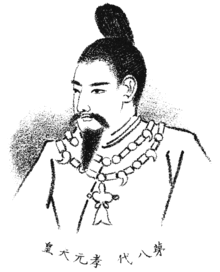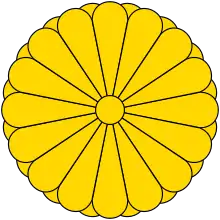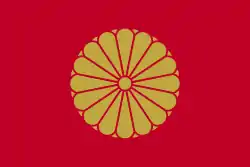Emperor Kōgen
Emperor Kōgen (孝元天皇, Kōgen-tennō), also known as Ōyamatonekohikokunikuru no Mikoto (大倭根子日子国玖琉命) was the eighth legendary Emperor of Japan, according to the traditional order of succession.[3][4] Very little is known about this Emperor due to a lack of material available for further verification and study. Kōgen is known as a "legendary emperor" among historians as his actual existence is disputed. Nothing exists in the Kojiki other than his name and genealogy. Kōgen's reign allegedly began in 214 BC, he had one wife and two consorts of which he fathered six children with. After his death in 158 BC, one of his sons supposedly became the next emperor.[5]
| Kōgen | |||||
|---|---|---|---|---|---|
 | |||||
| Emperor of Japan | |||||
| Reign | 214 BC – 158 BC (traditional)[1] | ||||
| Predecessor | Kōrei | ||||
| Successor | Kaika | ||||
| Born | 273 BC[2] | ||||
| Died | 158 BC (aged 115) | ||||
| Burial | Tsurugi no ike no shima no e no misasagi (劔池嶋上陵) (Kashihara) | ||||
| Spouse | |||||
| Issue | See below | ||||
| |||||
| House | Imperial House of Japan | ||||
| Father | Emperor Kōrei | ||||
| Mother | Kuwashi-hime | ||||
| Religion | Shinto | ||||
Legendary narrative
In the Kojiki and Nihon Shoki, only Kōgen's name and genealogy were recorded. The Japanese have traditionally accepted this sovereign's historical existence, and an Imperial misasagi or tomb for Kōgen is currently maintained; however, no extant contemporary records have been discovered that confirm a view that this historical figure actually reigned. Kōgen was born sometime in 273 BC, and is recorded as being the eldest son of Emperor Kōrei.[2] His empress mother was named "Kuwashi-hime", who was the daughter of Shiki no Agatanushi Oome. Before he was enthroned sometime in 214 BC, his pre-ascension name was Prince Ō-yamato-neko-hiko-kuni-kuru no Mikoto.[6] The Kojiki records that he ruled from the palace of Sakaihara-no-miya (軽之堺原宮, and in the Nihon Shoki as 軽境原宮) at Karu in what would come to be known as Yamato Province.[4] Emperor Kōgen had a chief wife (empress) named Utsushikome, along with two consorts. His first son was named Prince Ōhiko, and according to the Nihon Shoki was the direct ancestor of the Abe clan.[7] One of Kōgen's other sons named Prince Hikofutsuoshinomakoto was also grandfather to legendary Japanese hero-statesman Takenouchi no Sukune.[8] Emperor Kōgen reigned until his death in 158 BC, his second son was then enthroned as the next emperor.[6]
Known information
The existence of at least the first nine Emperors is disputed due to insufficient material available for further verification and study.[9] Kōgen is thus regarded by historians as a "legendary Emperor", and is considered to have been the seventh of eight Emperors without specific legends associated with them.[lower-alpha 1] The name Kōgen-tennō was assigned to him posthumously by later generations.[11] His name might have been regularized centuries after the lifetime ascribed to Kōgen, possibly during the time in which legends about the origins of the Yamato dynasty were compiled as the chronicles known today as the Kojiki.[10] While the actual site of Kōgen's grave is not known, the Emperor is traditionally venerated at a memorial Shinto shrine (misasagi) in Kashihara. The Imperial Household Agency designates this location as Kōgen's mausoleum, and its formal name is Tsurugi no ike no shima no e no misasagi.[3][5]
The first emperor that historians state might have actually existed is Emperor Sujin, the 10th emperor of Japan.[12] Outside of the Kojiki, the reign of Emperor Kinmei[lower-alpha 2] (c. 509 – 571 AD) is the first for which contemporary historiography is able to assign verifiable dates.[15] The conventionally accepted names and dates of the early Emperors were not confirmed as "traditional" though, until the reign of Emperor Kanmu[lower-alpha 3] between 737 and 806 AD.[10]
Consorts and children
Empress: Utsushikome (欝色謎命, d.157 BC), Oyakuchisukune's daughter
- First Son: Prince Ōhiko (大彦命), ancestor of all the Abe clan's descends.[7][lower-alpha 4]
- Prince Sukunaokokoro (少彦男心命)
- Second Son: Prince Wakayamatonekohikooobi (稚日本根子彦大日日尊), later Emperor Kaika.[4]
- Princess Yamatototo-hime (倭迹迹姫命)
Consort: Ikagashikome (伊香色謎命), Ōhesoki's daughter
- Prince Hikofutsuoshinomakoto (彦太忍信命), grandfather of the Takenouchi no Sukune (武内宿禰).[8]
Consort: Haniyasu-hime (埴安媛), Kawachi-no-Aotamakake's daughter
- Prince Takehaniyasuhiko ((武埴安彦命, d.88 BC)
See also
- Emperor of Japan
- List of Emperors of Japan
- Imperial cult
Notes
- Also known as the "eight undocumented monarchs" (欠史八代, Kesshi-hachidai).[10]
- The 29th Emperor[13][14]
- Kanmu was the 50th sovereign of the Yamato dynasty
- The first "Abe" was known as Abe no Omi (阿倍臣).
References

- "Genealogy of the Emperors of Japan" (PDF). Kunaicho.go.jp. Retrieved May 16, 2019.
- Kenneth Henshall (2013). Historical Dictionary of Japan to 1945. Scarecrow Press. p. 487. ISBN 9780810878723.
- "孝元天皇 (8)". Imperial Household Agency (Kunaichō) (in Japanese). Retrieved May 15, 2019.
- Brown, Delmer M. and Ichirō Ishida (1979). A Translation and Study of the Gukanshō, an Interpretative History of Japan Written in 1219. University of California Press. pp. 22, 248 & 252. ISBN 9780520034600.
- Ponsonby-Fane, Richard (1959). The Imperial House of Japan. Ponsonby Memorial Society. pp. 24, 30 & 418.
- Nussbaum, Louis-Frédéric (2002). Japan Encyclopedia. Harvard University Press. p. 542. ISBN 9780674017535.
- Asakawa, Kan'ichi (1903). The Early Institutional Life of Japan. Tokyo Shueisha. p. 140. ISBN 9780722225394.
- Shimazu Norifumi (March 15, 2006). "Takeshiuchi no Sukune". eos.kokugakuin.ac.jp. Retrieved May 16, 2019.
- Kelly, Charles F. "Kofun Culture". www.t-net.ne.jp. Retrieved May 15, 2019.
- Aston, William George. (1896). Nihongi: Chronicles of Japan from the Earliest Times to A.D. 697, Volume 2. The Japan Society London. pp. 109, 147–148.
- Brinkley, Frank (1915). A History of the Japanese People from the Earliest Times to the end of the Meiji Era. Encyclopaedia Britannica Company. p. 21.
Posthumous names for the earthly Mikados were invented in the reign of Emperor Kanmu (782–805), i.e., after the date of the compilation of the Records and the Chronicles.
- Yoshida, Reiji. (March 27, 2007). "Life in the Cloudy Imperial Fishbowl". Japan Times. Retrieved May 16, 2019.
- Titsingh, Isaac. (1834). Nihon Ōdai Ichiran (in French). Royal Asiatic Society, Oriental Translation Fund of Great Britain and Ireland. pp. 34–36.
- Brown, Delmer M. and Ichirō Ishida (1979). A Translation and Study of the Gukanshō, an Interpretative History of Japan Written in 1219. University of California Press. pp. 261–262. ISBN 9780520034600.
- Hoye, Timothy. (1999). Japanese Politics: Fixed and Floating Worlds. Prentice Hall. p. 78. ISBN 9780132712897.
According to legend, the first Japanese Emperor was Jimmu. Along with the next 13 Emperors, Jimmu is not considered an actual, historical figure. Historically verifiable Emperors of Japan date from the early sixth century with Kimmei.
Further reading
- Asakawa, Kan'ichi. (1903). The Early Institutional Life of Japan. Tokyo: Shueisha. OCLC 4427686; see online, multi-formatted, full-text book at openlibrary.org
- Aston, William. (1896). Nihongi: Chronicles of Japan from the Earliest Times to A.D. 697. London: Kegan Paul, Trench, Trubner. OCLC 448337491
- Brown, Delmer M. and Ichirō Ishida, eds. (1979). Gukanshō: The Future and the Past. Berkeley: University of California Press. ISBN 978-0-520-03460-0; OCLC 251325323
- Chamberlain, Basil Hall. (1920). The Kojiki. Read before the Asiatic Society of Japan on April 12, May 10, and June 21, 1882; reprinted, May, 1919. OCLC 1882339
- Nussbaum, Louis-Frédéric and Käthe Roth. (2005). Japan encyclopedia. Cambridge: Harvard University Press. ISBN 978-0-674-01753-5; OCLC 58053128
- Ponsonby-Fane, Richard Arthur Brabazon. (1959). The Imperial House of Japan. Kyoto: Ponsonby Memorial Society. OCLC 194887
- Titsingh, Isaac. (1834). Nihon Ōdai Ichiran; ou, Annales des empereurs du Japon. Paris: Royal Asiatic Society, Oriental Translation Fund of Great Britain and Ireland. OCLC 5850691
- Varley, H. Paul. (1980). Jinnō Shōtōki: A Chronicle of Gods and Sovereigns. New York: Columbia University Press. ISBN 978-0-231-04940-5; OCLC 59145842
| Regnal titles | ||
|---|---|---|
| Preceded by Emperor Kōrei |
Legendary Emperor of Japan 214 BC – 158 BC (traditional dates) |
Succeeded by Emperor Kaika |
